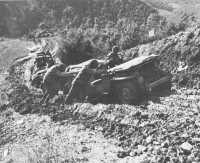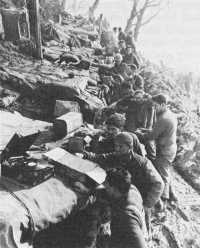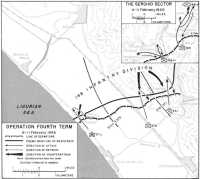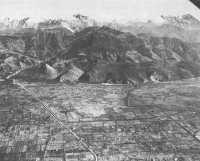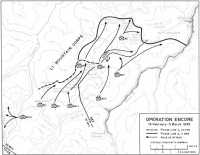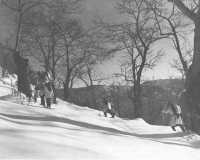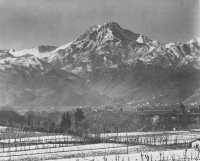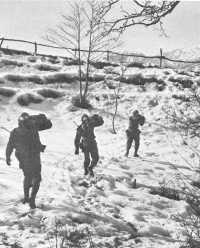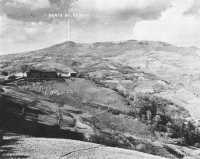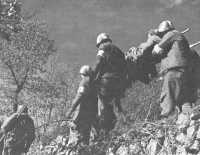Chapter 24: Through the Winter
Sustaining the Armies
Except for three relatively brief, limited-objective operations, one in the Eighth Army and two in the Fifth, most of the front from sea to sea during the final winter of the war lay dormant beneath a coat of snow and ice. Even the wide-ranging and largely unchallenged Allied air arm was grounded much of the time as frequent fog or storm covered much of the country. Yet deep in the rear areas of both armies the countless activities required to keep modern field armies alive and functioning continued at an undiminished pace.
The numerous rear echelon units of both Allied armies had three main tasks: to sustain and nourish their forces, repair and salvage equipment, and assemble and forward supplies for the pending spring offensive. The U.S. Army Transportation Corps, for example, moved vast quantities of supplies from port to depot; army signal units manned switchboards, often handling as much daily traffic as a small city, and maintained a vast network of telephone and radio communications; and quartermaster units employed thousands of Italian civilians to repair and manufacture nonstandard items of winter clothing. Except for those abundant reserves of civilian manpower, there were few other indigenous resources in the Allied-occupied zone of Italy from which to draw to maintain the armies.1
The U.S. Fifth Army was sustained largely by a 5,000-mile supply line extending from the United States across the Atlantic, the western Mediterranean, and miles of rugged Italian terrain. Convoys of freighters brought their cargoes from the United States to the Peninsular Base Section at either Naples or Leghorn, the latter having become after mid-November the army’s main supply base in Italy. From the ports transportation corps units moved the supplies to dumps located in the vicinity of Lucca, Pistoia, and Florence, with shipments from Naples moving by rail. After March 1945 the service was extended from Leghorn to Florence.
Important though the railroads were for long distances, the burden of short haul movement of supplies fell largely to motor transport. From the major dumps in the Arno valley long truck convoys moved day and night up and down fifty miles of steep, winding mountain roads to deliver supplies to the forward elements of the II Corps. From there jeeps, and in the end, mules and men took over. During the winter 15 Italian pack mule companies with an approximate strength of 3,875 animals operated in support of the Fifth Army.
The unsung heroes of the supply operations were the engineer, transportation, and quartermaster units. Transportation units kept traffic moving over roads that engineers not only kept open but even managed to improve for the heavy traffic scheduled for future operations. Thousands of Italian civilians helped. In addition to providing warmer clothing and improved rations, the quartermaster units operated and maintained rest centers in the Arno valley, including centers at historic Florence and at Montecatini, where the troops could enjoy the therapeutic properties of sulphur springs long famed among European upper classes. Soft beds were among the amenities that a fashionable watering place could offer, even in wartime.
Even at the front life became more endurable. An army-wide campaign to winterize living quarters, made possible by a static front, gave the infantrymen a few more creature comforts. Although men actually manning the forward positions remained in foxholes, they made them as comfortable as human ingenuity could devise. In support and reserve positions troops constructed snug dugouts, and in some cases enjoyed the comparative comforts of pyramidal tents equipped with oil- or lignite-burning stoves. For evacuation hospitals, Nissen huts and other prefabricated buildings replaced the tents. The men would spend the winter in as comfortable circumstances as possible for a field army in a war-devastated land.
Strengthening the Army
The winter lull also afforded Allied commanders an opportunity to reinforce their armies. On 27 December, about the time the Germans made their brief foray into the Serchio valley, the first units of the U.S. 10th Mountain Division, under the command of Maj. Gen. George P. Hays, landed in Italy, and within two weeks the entire division was ashore.2 In late March the Japanese-American 442nd Infantry, with attached units, returned from France, where the regiment had served since September of the preceding year. At the same time the Legnano Combat Group, an Italian infantry unit of about brigade strength, one of five trained and equipped by the British, was assigned to the Fifth Army. The remaining four Italian combat groups composed of veteran soldiers of the old Italian army, joined the Eighth Army. There were also a number of Italian engineer, quartermaster, and medical units assigned or attached to various Allied commands.3
Also in March the 536th and 527th Field Artillery Battalions, both equipped with powerful 8-inch howitzers, arrived from the United States. Those were later joined by the 530th Field Artillery Battalion (155-mm. guns), the 765th and 766th Field Artillery Battalions (155-mm. howitzers), and headquarters of the 428th Field Artillery Group. In addition there also arrived the 679th Tank Destroyer Battalion, equipped
Motor Transport in Northern Apennines
with towed 3-inch guns. To those American units were added a section (4 guns) of the British 11/54 Super Heavy Regiment and a 240-mm. howitzer unit. Further reinforcements came from the 15th South African Field Artillery Regiment and from the 111th Field Regiment, the latter recently returned from duty with the Yugoslav partisans.
To ease supply and administration all attached British artillery units, except the heavy artillery, were placed under the operational control of IV Corps. The four guns of the 11/54 Super Heavy Regiment remained with II Corps in the Highway 65 sector. To make a more equitable distribution of heavy artillery for the spring offensive, Clark would later transfer the British 61st Heavy Regiment (7.2-inch howitzers and 155-mm. guns) from the II Corps to Eighth Army.
The need to build ammunition reserves, a factor in the decision to postpone resumption of the offensive until spring, was, with the increase in artillery units, all the more essential. From November in the Fifth Army and January
in the Eighth, severe restrictions were placed on the use of artillery to enable both armies to begin accumulating large stocks of ammunition. With the arrival of regular shipments from the United States, ammunition dumps in both army areas were by March at last filled to overflowing. Regular depots, operated by the Peninsular Base Section in the vicinity of Pistoia and Leghorn, could store no more ammunition, necessitating the retention of 20,000 additional tons at Naples. The U.S. II Corps also had built up large stocks in forward areas. By the first of March ammunition stocks were so large that daily allotments per gun were increased about one-third throughout the Fifth Army to make room for subsequent shipments. By the end of March supplies of ammunition in the Fifth Army had reached the 60-day reserve level authorized by the War Department.4
Regrouping the Army
In addition to maintaining and strengthening the Fifth Army, General Truscott regrouped his divisions in order to rest the troops and reorganize and train units for the spring offensive. The process went on throughout the month of January in the Fifth Army. Most of the units that had been detached from the II Corps in December to reinforce against the German counterattack in the Serchio valley were returned to the central sector including the 135th Regimental Combat Team from Viareggio to its parent division, the 34th, and the entire 85th Division.
Soldiers relaxing during lull in battle
The 92nd Division’s 365th Regimental Combat Team, which had been attached temporarily to the II Corps as additional relief for the infantry divisions east of Highway 65, moved back to control of its parent division in the Serchio valley sector, formerly held by the 8th Indian Division. The Indian division then moved into a corps rest area near Pisa. The 10th Mountain Division’s 86th Mountain Infantry Regiment, the first unit of that division to arrive, was attached to the IV Corps and relieved the 434th and 900th AA Battalions and the British 39th Light AA Regiment in the division-sized Task Force 45’s sector northwest of Pistoia. In turn, the two American antiaircraft battalions, functioning since the previous autumn as infantry, became part of a newly formed 473rd Infantry Regiment.5
By 28 January the 10th Mountain Division’s other two regiments had arrived and joined the first regiment in the Reno valley on the IV Corps’ right wing where the division was attached to Task Force 45. At that point the IV Corps front was held from left to right by the 92nd Division, Task Force 45, including the 10th Mountain Division, and the division-sized Brazilian Expeditionary Force, with the 8th Indian Division constituting a reserve. (Map XIV)
Similar shifts of major units also took place on the II Corps front. Early in January the 85th Division began relieving the British 1st Division in the Monte Grande area on the left flank of the 13 Corps, thus extending the right flank of the II Corps eastward. With the return of the British 13 Corps to the operational control of the Eighth Army on 18 January, the Fifth Army’s new boundary paralleled the Firenzuola–Imola road two miles to the east as far as a point opposite Castel del Rio, where it turned northward to skirt the eastern edge of Monte Grande and reach Highway 9 at Castel San Pietro, seven miles northwest of Imola. The British 1st Division, formerly under 13 Corps, came under control of Allied Force Headquarters and eventually was transferred to the Middle East. That left the 13 Corps in control of only the British 6th Armoured and 78th Infantry Divisions.6
During the month a round robin of relief of one division by another gave all a brief rest out of the line. At the end of January the II Corps held its sector from left to right with the South African 6th Armoured Division and the 88th, 34th, and 85th Infantry Divisions, the latter on the right flank adjacent to the British 13 Corps. The 91st Division lay in II Corps reserve; the 1st Armoured Division and the 8th Indian Division were in Army reserve.
Eliminating Enemy Bridgeheads on the Eighth Army Front
The British Eighth Army commander, General McCreery, meanwhile was similarly turning his attention to strengthening and tidying his front, which except for two potentially troublesome enemy bridgeheads, lay along the east bank of the Senio River. Cessation of the army’s offensive in mid-December had left the 714th Jäger Division in possession of a bridgehead some five miles northwest of Ravenna, while the 278th Infantry Division held a second bridgehead to the southwest of the first, between the towns of Cotignola and Franarola. Eliminating those bridgeheads was to occupy the Eighth Army for the next few days.7
The first of the two bridgeheads lay opposite the Canadian Corps and could be used as a springboard for a counterattack on Ravenna, while the second and smaller of the bridgeheads lay opposite the British 5 Corps. Less of a threat than the first, the second had thus far been tenaciously defended, and the existence of both extended the length of the front and the troops needed to hold it. General McCreery determined to eliminate the two bridgeheads as soon as the frozen earth afforded firm footing for tanks and the weather enabled tactical aircraft to go aloft.
The opportunity came on the morning of 2 January when a period of clear, cold weather set in. Along the Adriatic flank the Canadian 5th Armoured Division moved against the bridgehead north of Ravenna by way of a dry river bed, making use of dikes for a covered route of approach. The town of Conventello fell during the first morning and despite a small German counterattack, the armor on the third day crossed a canal to gain access to the rest of the area still held by the Germans south of the Reno River. By evening of 5 January almost all the territory was under Canadian control. The Italian Cremona Battle Group subsequently assumed responsibility for the sector.
Meanwhile, on 3 January the British 5 Corps attacked the other bridgehead and took only two days to eliminate it. By the end of the first week in January the Eighth Army was drawn up along the east bank of the Senio from the mountains to the sea. At the same time General McCreery withdrew the headquarters of the Polish corps for a period of rest, its former sector passing to the British 5 Corps. Until the final offensive began in April McCreery made no significant changes on a generally inactive front.
German Dispositions
In spite of the relative inactivity of the winter months, the German, as did the Allies, experienced steady attrition through combat as well as noncombat causes, which the Army Group C’s replacement system would never be able to make good. In January, for example, losses totaled 13,526, of which 1,299 were killed, 3,132 wounded, 1,417 missing, and 7,678 sick from various causes, mostly respiratory ailments. Yet during the month only 5,600 replacements arrived in northern Italy from the Reich. Among the returnees to Army Group C in January was Field Marshal Kesselring, who, after a short convalescent leave, arrived on 15 January to resume command of the German forces in Italy. General Vietinghoff, who had commanded the army group during his absence, left to take command of an army group on the Baltic front.8
In January the Germans took advantage of poor flying weather for Allied aircraft to move entire divisions in and out of northern Italy. First to depart, the 356th Infantry Division, moving to a beleaguered Hungarian front, managed
to traverse the Brenner Pass by rail without incident. At the end of February the 16th SS Panzer Grenadier Division left for the same sector, while several companies of mountain troops moved to the western front. To take the place of the two departing divisions, the 278th Infantry Division arrived from Belgium, where it had organized the previous year, and the 710th Infantry Division arrived from occupation duty in Denmark.
As both Allied armies in Italy closed up to positions from which a coordinated attack might be launched against Bologna, General Vietinghoff, then still Army Group C commander, reacted by shifting the Tenth Army boundary westward from the Santerno to the Reno valley, thus bringing von Senger’s XIV Panzer Corps into the Tenth Army and uniting under one command the most active battle fronts. That move brought the number of corps operating under the Tenth Army to five: the LXXIII and XCVII Corps with four divisions between them, guarding the Adriatic flank and the coastal areas of the Gulf of Venice to the Istrian peninsula; Herr’s LXXVI Panzer Corps with four divisions, holding a relatively narrow sector from Bagnacavallo, ten miles northeast of Faenza, to a point just south of Highway 9; and Schlemm’s I Parachute Corps with six divisions east of Highway 65 and Senger’s XIV Panzer Corps with four divisions west of the highway, the two jointly holding the critical Bologna sector. To the Tenth Army’s right the Fourteenth Army commanded two corps, the LI Mountain Corps with two German and two Italian divisions, and the Corps Lombardia with the equivalent of two Italian divisions and elements of a German division. The Army Group Liguria, commanded by Mussolini’s Defense Minister Rodolfo Graziani, held the coastal defenses of the Gulf of Genoa to the Fourteenth Army’s right rear with three German divisions and one Italian division. Two divisions each were in Tenth Army and Army Group C reserve.
Scattered throughout the Army Group rear areas were several miscellaneous units, mostly non-German, including Italian police units totaling about a hundred thousand men. They were of little value other than for local security.9
Although the German commanders foresaw no major Allied military operations in Italy before the spring, they were less certain of whether the Allies might attempt limited objective attacks during the winter. While Field Marshal Kesselring assumed that Allied commanders wanted to rest their troops, he also believed they wanted to prevent him from doing the same. Thus the Eighth Army’s attacks to eliminate the German bridgeheads over the Senio River in January came as no real surprise. Nor did limited attacks by the U.S. Fifth Army in February. What was surprising was the timing and strength of the attacks.10
Operation FOURTH TERM
As early as 28 December, as an aftermath of the limited German operations in the Serchio valley, General
Map 9: Operation FOURTH TERM, 8–11 February 1945
Truscott told the IV Corps commander, General Crittenberger, to get ready to clear the valley as far north as Castelnuovo and the coastal area as far as La Spezia.11 After reflecting upon a shortage of combat-worthy units available for the drive and the fact that the Gothic Line defenses in that area were still intact, General Truscott two weeks later lowered his sights considerably. At that point he called for only limited attacks “in order to improve positions,” particularly in the sector of the 92nd Division.12
In response, General Almond and his staff of the 92nd Division planned a two-phase operation given the code name FOURTH TERM. The first phase, a diversion for the second, was to take the division up the Serchio valley as far as
the Lama di Sotto Ridge, four miles northwest of Tiglio. Then the main attack was to be aimed at securing the Strettoia Hill mass, about three miles northeast of Forte dei Marmi, overlooking both the coastal corridor and the approaches to the town of Massa, five miles north of Forte dei Marmi. Capture of the hill mass could be expected to open up the coastal roads as far as Massa and bring corps and division artillery within range of Italian naval guns at La Spezia.13
The Serchio valley operation began on 4 February as the 365th Infantry set out along a ridge east of the Serchio, while the attached 366th Infantry kept abreast west of the river. (Map 9) All went well at first as the 366th occupied the village of Gallicano, and the 365th pushed far ahead to reach the foot of its objective, the Lama di Sotto ridge. After only token resistance, opposing Italian units simply melted away into the mountains. Then over the next two days, as the 366th Infantry moved into the next village of Calomini and the 365th moved onto the ridge itself to capture the village of Lama, signs developed that German units had begun to replace the faltering Italians. A counterattack during the night of 7 February by a battalion of the 148th Division’s 286th Infantry Regiment confirmed the fact. Striking at troops of the U.S. 365th Infantry east of Serchio, the Germans forced them to withdraw from Lama and back down the slope of the ridge to within three-quarters of a mile of the original starting point of the operation. To maintain contact, the 366th Infantry withdrew a similar distance. When the Germans made no effort to press their advantage, both sides contented themselves with eyeing each other warily. A diversionary operation, the attack in the Serchio valley had gained little ground in the end but had at least demonstrated that the two inexperienced American regiments could attack and seize high ground against moderate resistance, even though they failed to hold it.
The 92nd Division’s real test came in the coastal corridor to the west where General Almond planned for the division’s 370th Infantry to capture the Strettoia Hills, three peaks three miles inland overlooking the coastal corridor. The regiment’s three battalions were to leapfrog in turn from one hill to the next in hope of maintaining momentum while at the same time providing a defense in depth against counterattack. On the right flank the 371st Infantry was to keep abreast, while on the coastal flatlands a tank-infantry task force built around the 366th Infantry’s 3rd Battalion was to cross the Cinquale Canal between the coastal highway and the sea four miles south of Massa.
Early on 8 February, as the limited offensive began, Generals Truscott and Crittenberger, along with General Almond, watched from an observation post in the hills northeast of Forte dei Marmi. Unfortunately, from the very beginning the plan began to fall apart. After covering only 800 yards, the 371st Infantry stumbled into an enemy mine field and came to a halt, thereby exposing the 370th Infantry’s right flank. Supported by aircraft of the 86th Fighter Squadron, the leading battalion
Area north of Cinquale Canal, 92nd Division zone
of the 370th Infantry nevertheless continued to press ahead and by late afternoon had occupied its initial objective. Hardly had the men dug in when a shattering barrage of mortar fire signaled a sharp counterattack. The Germans quickly overran the forward company and forced the second to withdraw down the eastern slopes of the Strettoia Hills. Units of another battalion proceeding according to plan to leapfrog to the next peak, ran into men falling back under enemy fire. In the resulting confusion the attack broke down completely. At dawn on the third day an urgent message to the battalions from the regimental command post disclosed the regiment’s plight: “We have no reserve except our command post . . . It is very important that we let nothing stop us from getting every available man together. Search all houses and places for stragglers. We can expect pressure today and be ready for it. Report every hour on progress and number of men rounded up.”14
That pattern of failure was repeated on the narrow coastal plain to the left of the Strettoia Hills. After three days of costly but inconclusive fighting a task force composed of the 366th Infantry’s 3rd Battalion with attached armor and engineers failed to get beyond the shallow Cinquale Canal. Large caliber naval guns firing from the Italian coastal defenses at Punta Bianca ten miles northwest of the canal contributed to the failure.
So widespread were disorganization and straggling throughout the 92nd Division and its attachments that further attempts to continue the operation seemed futile. General Almond canceled it on the third day, the 11th. The limited thrust had cost the 92nd Division 47 officers and 659 enlisted men killed, wounded, and missing, among them two battalion commanders and many of the more capable company grade officers. That had been a high price to pay for 145 enemy captured and virtually no ground gain. Combined with the shortcomings demonstrated earlier in the reverse in the Serchio valley, the disproportionately high losses among officers and the rampant straggling convinced General Truscott that he would be unable to count on the division as then constituted for further offensive action.
A Forecast of Spring
A week after the ill-fated operation by the 92nd Division, General Crittenberger’s IV Corps began the second of its mid-winter limited offensives, one designed to win better positions for starting the spring offensive, which was no longer to focus, as it had earlier, on capture of Bologna. With the passing of cold weather the city’s attraction as winter quarters also would pass, and no longer was Bologna needed as a communications center for exploitation into the Po Valley. Allied commanders had come to think beyond a deliberate thrust into the valley—to wide-sweeping movements by both the Fifth and Eighth Armies aimed at encircling not only Bologna but also entire German armies.15
General Crittenberger had selected for the major role in the limited operation his only fresh, untried division, the recently arrived 10th Mountain Division. Because of specialized mountain training and comparatively light organic artillery—there were only three battalions of 75-mm. pack howitzers as contrasted with the three battalions of 105-mm. howitzers and one of 155-mm. howitzers in the standard infantry division—commanders in other theaters had declined the division’s services, but the specialized training enhanced the division’s attractiveness to an army engaged in mountain warfare.16
Activated in the summer of 1943 at Camp Hale, Colorado, the 10th Mountain Division included the 85th, 86th, and 87th Mountain Infantry Regiments. With its 75-mm. pack howitzer artillery support and few motor vehicles, the division resembled a German Jäger or light infantry division. In sharp contrast to the unfortunate 92nd Division, or, for that matter, almost any other U.S. division, the ranks of the 10th Mountain Division contained a high percentage of
Map 10: Operation ENCORE, 19 February-5 March 1945
college-trained men, including winter sports enthusiasts and members of mountain climbing and skiing clubs, most of whom had volunteered for service with the division through an unorthodox recruitment campaign conducted by the civilian National Ski Patrol System.
The division commander, General Hays, had come favorably to General Marshall’s attention during World War I when during a heavy artillery barrage Hays had ridden on horseback through enemy fire to locate targets for his artillery. For this action Hays had received the Medal of Honor. In World War II Marshall had transferred him from command of the 2nd Division artillery in France to command of the mountain division just before its departure for Italy. Truscott would later rate him as one of his ablest battle leaders.17
Plans for the new offensive—code named Operation ENCORE—were initiated at army instead of corps level. Truscott’s intention was to secure high
Ski Patrol, 10th Mountain Division
ground dominating a ten-mile section of Highway 64. Averaging about 3,800 feet in height, the objective consisted of a series of mountain peaks and ridges about five miles west of the highway. From it the Germans had excellent observation over a large section of Highway 64 and into the American positions east of the Reno River. In American hands, the terrain would provide observation almost as far as the Po Valley, about twenty miles away. North of Vergato the terrain, though still mountainous, descends gradually toward Highway 9 and the Lombardy Plain. Inherent in General Truscott’s concept for the limited objective operation was the possibility of an eventual westward shift of the main axis of the Fifth Army’s spring offensive into the Po Valley.18
In early February the 10th Mountain Division held positions in the valley of the Silla River not far from its confluence with the Reno River, through
Apennines, IV Corps sector
whose valley Highway 64, one of the two main routes leading to Bologna on the Fifth Army’s front, runs. (Map 10) Dominating the region were two ridges whose highest peaks rose between three thousand to nearly five thousand feet. Known to American troops as the Riva Ridge, the first of the two overlooked the mountain division’s left flank and dominated routes of approach to the second: the Monte Belvedere–Monte della Torraccia Ridge.
The Riva Ridge paralleled the left flank of the division’s zone of operations for four miles. The side of the ridge facing the division was a cliff, rising in some places almost 1,500 feet above the valley floor. Since the ridge would have to be cleared before the main attack could move toward Monte Belvedere, the mountain troops would have to scale that cliff. Once the Monte Belvedere–Monte della Torraccia ridge was in hand, the division was to open a second phase of the attack to continue northeastward about four miles and
Artillery ammunition being brought forward, 10th Mountain Division
occupy a series of lower ridges from which roads descended into the Po Valley.19
General Hays had secretly assembled his troops some two to three miles south and east of the two ridges.20 To the right was the Brazilian Expeditionary Force, holding with its three regiments a three-mile sector between the mountain division’s right flank and the Reno River. The Brazilians were to cover the mountain division’s right flank. To make up for the mountain division’s lack of heavy fire support, General Crittenberger attached the 175th Field Artillery Battalion with 105-mm. howitzers, the 84th Chemical (4.2-inch) Mortar Battalion, two tank destroyer battalions, and a tank battalion.
For the men of the 10th Mountain Division, crossing the snow-covered ground would be especially difficult because of limited concealment provided by nothing more than scattered clumps of stunted trees. Vehicular movement also would be difficult because the few roads and trails crossing the area were narrow and in poor condition. The burden of transport would fall mainly upon pack mules, full-tracked “Weasels,” and jeeps. Tanks could, by skillful handling, be brought forward in small groups as far as the village of Querciola, a little more than a mile southwest of Monte Belvedere.
Through interrogation of enemy prisoners, the mountain division’s G-2 had determined that the peaks and ridges opposite both the mountain division and the Brazilians were lightly held by troops of the 232nd Infantry Division, with all three regiments in line across an 18-mile front. Originally intended only for rear area duty, most of the division’s troops were either older men or convalescents intercepted en route to their former units on the Eastern front. In reserve were a fusilier battalion and elements of a mountain battalion.21
Into the Mountains
In the bitter cold, as darkness settled over the valley below Monte Belvedere, teams of picked rock climbers slung
coils of ropes over their shoulders and hung clusters of pitons and snap links to their belts. For long months these men had trained in the Rocky Mountains for just this kind of action—scaling the face of 1,500 Riva Ridge. Setting out soon after dark on 18 February, a climbing team from each of the three rifle companies of the 86th Mountain Infantry’s 1st Battalion and another from the 2nd Battalion was to prepare the way. Climbing in the darkness, the men drove steel pitons into the rock, hooked snap links to them, then fastened ropes to the snap links to provide fixed hand lines for the main body of climbers to follow.
When the climbing teams reached the rim of the ridge, they signaled to the main body of the 1st Battalion, 86th Infantry, in the valley below. The battalion set out in a column of companies toward the base of Riva Ridge, each company to take a different route up the cliff to a series of peaks along the ridge. Aided by the ropes, the men scaled the cliff without difficulty. Before dawn, virtually the entire battalion had reached the top undetected.
The mountain infantry may have been aided by the fact that even as the men were working their way up, the 232nd Fusilier Battalion was relieving a battalion of the 1044th Infantry Regiment on the ridge. Discovering the Americans with the coming of daylight, the enemy managed to mount three minor counterattacks, but the mountain infantry repulsed them without much trouble. As indications of enemy withdrawal developed in the afternoon, a patrol probed along the ridge, encountering only a seven-man enemy detachment. Three were captured, four killed. By the end of the day the entire ridge was secured.
The division’s left flank protected by capture of the Riva Ridge, troops of the 85th and 87th Mountain Infantry Regiments set out that night in silence for a forward assembly area at the base of the Monte Belvedere–Monte della Torraccia hill mass. Eschewing an artillery preparation in hope of achieving surprise, the regiments attacked an hour before midnight. While the 85th Mountain Infantry moved frontally against Monte Belvedere and adjacent Monte Gorgolesco, the 87th moved up the western slopes toward a trio of villages lying between Belvedere and the Riva Ridge, and from there was to proceed to the Valpiana Ridge, northwestern spur of Monte Belvedere. Gaining the Valpiana Ridge would have the effect of outflanking defenses on the crest of Monte Belvedere.
Dispensing with an artillery preparation apparently paid off, for men of the 87th Mountain Infantry were virtually atop the enemy’s outposts before they met resistance. From a line of bunkers, machine gun positions, and fortified houses, the Germans fought back sporadically, while extensive minefields created further hitches. Both leading battalions nevertheless made steady progress, so that within a few hours the Valpiana Ridge and two of the three villages were in hand.
The story was much the same with the 85th Mountain Infantry in the frontal drive against the two heights. At Monte Belvedere the first resistance developed 300 yards short of the summit, but during the next three hours the mountain infantrymen fought their way to the top. Others had a similar
Monte Belvedere massif from Lizzano, 10th Mountain Division sector
experience on Monte Gorgolesco. Protecting the division’s right flank, a battalion of the 86th Mountain Infantry occupied a village on Monte Gorgolesco’s northeastern slope.
As the advance continued northeastward toward the last peak of the hill mass, Monte della Torraccia, the mountain division’s artillery and its supporting guns came into play, with counterbattery fire that partially neutralized enemy guns. With the coming of daylight, L-5 artillery spotter aircraft adjusted fires with marked accuracy while also directing fighter-bombers to targets, some within 600 yards of the American positions. During the first two days British Spitfires and U.S. P-47’s flew a total of 412 sorties in support of the attack.
Despite the artillery and aerial support, the enemy early on the 21st managed a counterattack by a reinforced battalion against the 3rd Battalion, 85th Mountain Infantry, on Monte Belvedere. The counterattacking force represented first commitment of troops of the 714th Jäger Division, which by
Evacuating casualties over mountain trail
chance had been en route from the Adriatic flank to the Monte Belvedere sector even before the 10th Mountain Division’s attack had begun. Reinforcing were portions of a battalion of the 1043rd Infantry Regiment, the 232nd Division’s local reserve. Although the Germans failed to regain any of the lost ground the counterattack prompted a temporary pause in the American advance toward Monte della Torraccia.
Meanwhile the troops of the Brazilian Expeditionary Force entered the fight to protect the 10th Mountain Division’s right flank by seizing Monte Castello, about a mile southeast of Monte della Torraccia. Unknown to the Brazilians, the American drive toward Monte della Torraccia had precipitated an enemy withdrawal from Monte Castello. Behind a 15-minute artillery preparation, the Brazilian 1st Regiment converged on the objective from south and southwest and quickly gained the summit. Soon after nightfall the last resistance from a small rear guard ceased.
The counterattack on Monte Belvedere at an end and the Brazilians moving on Monte Castello, the 85th Mountain Infantry during early afternoon
of the 21st renewed the drive for Monte della Torraccia. A fresh battalion, the 2nd, led the way and quickly discovered that the Germans intended to make a fight of it. In the heavy combat that followed, casualties were high, including the 2nd Battalion commander and his heavy weapons company commander. Three salvos from enemy artillery fire were particularly devastating until counterbattery fire silenced the guns. Throughout the night and well into the next day the battalion clung to positions 400 yards short of the objective, unable to push farther. By late afternoon of the 22nd the battalion was down to some 400 effectives and was low on ammunition, food, and water. The battalion’s condition prompted General Hays to relieve the 85th Mountain Infantry with the 86th.
During the afternoon of the 23rd the 3rd Battalion, 86th Mountain Infantry, came forward to make the final assault against the crest of Monte della Torraccia. As the battalion began to attack the next morning, tactical aircraft strafed and bombed hedgerows sheltering and concealing enemy gunners. Company I was atop the objective within an hour, and by early afternoon all of Monte della Torraccia and ridges north and northeast of it were in friendly hands. Although a battalion of German mountain troops from the 232nd Division’s reserve counterattacked vigorously, the 3rd Battalion with strong artillery support held fast. By nightfall the entire complex of heights from the Riva Ridge to Monte Castello was firmly in hand.
In a first full-scale battle action, men of the 10th Mountain Division had fought with courage and determination, wresting a stretch of rugged terrain from the enemy at a cost of just over 900 casualties, of which 203 were killed. However deplorable any losses at all, that was hardly an alarming figure for a first engagement. Field Marshal Kesselring would later call the division “outstandingly efficient.”22 From General Crittenberger came the message: “. . . you have done a wonderful job. All eyes are on you. You are carrying the ball.” That was a statement that General Truscott could heartily endorse, for carrying the ball was exactly what he expected the division to do when the army’s offensive resumed in the spring.23
The Second Phase
For the next step of the limited objective operation, the 10th Mountain Division and the Brazilian Expeditionary Force were to advance on a more northeasterly axis, generally toward the road junction town of Vergato, on Highway 64, twelve miles northeast of Monte Belvedere. The objective was another line of hill crests or peaks roughly 4 miles to the north and northeast of the positions gained in the first phase, whence the terrain the rest of the way to the Po Valley was downhill. The peaks would serve as the jump-off line in this sector for the spring offensive. From west to east, they were Monte Grande d’Aiano, Monte della Spe, Monte della Castellana, and Monte Valbura.
Although scheduled to begin on 1 March, the drive had to be postponed for two days because of poor weather.
It produced few surprises. Again General Hays employed two regiments abreast—the 86th Mountain Infantry on the left, the 87th on the right—while the Brazilians kept pace with the mountain infantry to protect the right flank. As before troops of the 232nd Infantry and 714th Jäger Divisions fought back from every crest and village until forced out by the combined force of artillery, air, and aggressive foot troops. Where tank destroyers could negotiate the rugged terrain, they proved of particular value, especially when the Germans holed up in thick-walled stone houses. Almost inevitably the Germans counterattacked, but in no case were they successful.
In two days—3 and 4 March—the two assault regiments took all intermediate heights and also captured Monte Grande d’Aiano, whereupon early on 5 March General Hays sent his third regiment, the 85th, to seize Monte della Spe and Monte della Castellano. Despite the heaviest defensive fires of the three-day drive, the 1st Battalion by late afternoon stood on top the summit of Monte della Spe. The 2nd Battalion, meanwhile, encountered such heavy fire on the slopes of Monte della Castellana that the men had to withdraw and take another approach, but the second try carried the position.
Those heavy defensive fires on 5 March were the first indication that the Germans were attempting to reinforce the sector. Aware of heavy losses in both defending divisions during the first phase of the American drive, Field Marshal Kesselring had been intending to replace the two with a fresh division, but the second phase opened before he could accomplish it. The renewed thrust disturbed Kesselring. Was this the beginning of a major offensive aimed at encircling Bologna from the west?
Unable to determine for sure, Kesselring deemed he could ill afford to take a chance. He saw no choice but to rush his major reserve, the 29th Panzer Grenadier Division, then undergoing reorganization, to the threatened sector. It was, he observed, “a grim decision [but] unfortunately. . . absolutely unavoidable.”24 However limited the scope of the operation from the American viewpoint, the Germans saw it as a serious threat. The fight appeared to have developed into “a battle for possession of the gateway into the Po Valley at both the operationally and tactically most unfavorable point.”25
Shortly before midnight on 5 March the 15th Panzer Grenadier Regiment, first contingent of the 29th Panzer Grenadier Division to arrive, mounted the first in a series of four counterattacks against the 1st Battalion, 87th Mountain Infantry, on Monte della Spe, the apex of the American salient. Although the German infantrymen actually penetrated the battalion’s positions at one point, the Americans drove them back in fierce hand-to-hand fighting. When the fourth counterattack failed, the Germans backed off and contented themselves with harassing artillery fire.
Truscott Halts the Attack
Anxious lest Kesselring become so alarmed that he would develop defensive positions astride Highway 64 as formidable as those on Highway 65,
Truscott ordered the IV Corps to halt in place. The objectives of the limited offensive were in hand in any case. At a cost of another 549 casualties, including 106 killed, the mountain division had brought the right wing of the IV Corps abreast of the II Corps and in control of excellent jump-off positions for the spring offensive.26
Over the next few days the Brazilians shifted position to the 10th Mountain Division’s left, while the mountain troops extended their control to embrace two additional features on the right, Monte Valbura and a second Monte Belvedere. The 10th Mountain Division now held a six-mile front between Monte Grande d’Aiano and Highway 64, the favorable jump-off point they had been seeking for an offensive down the Reno valley and Highway 64.
